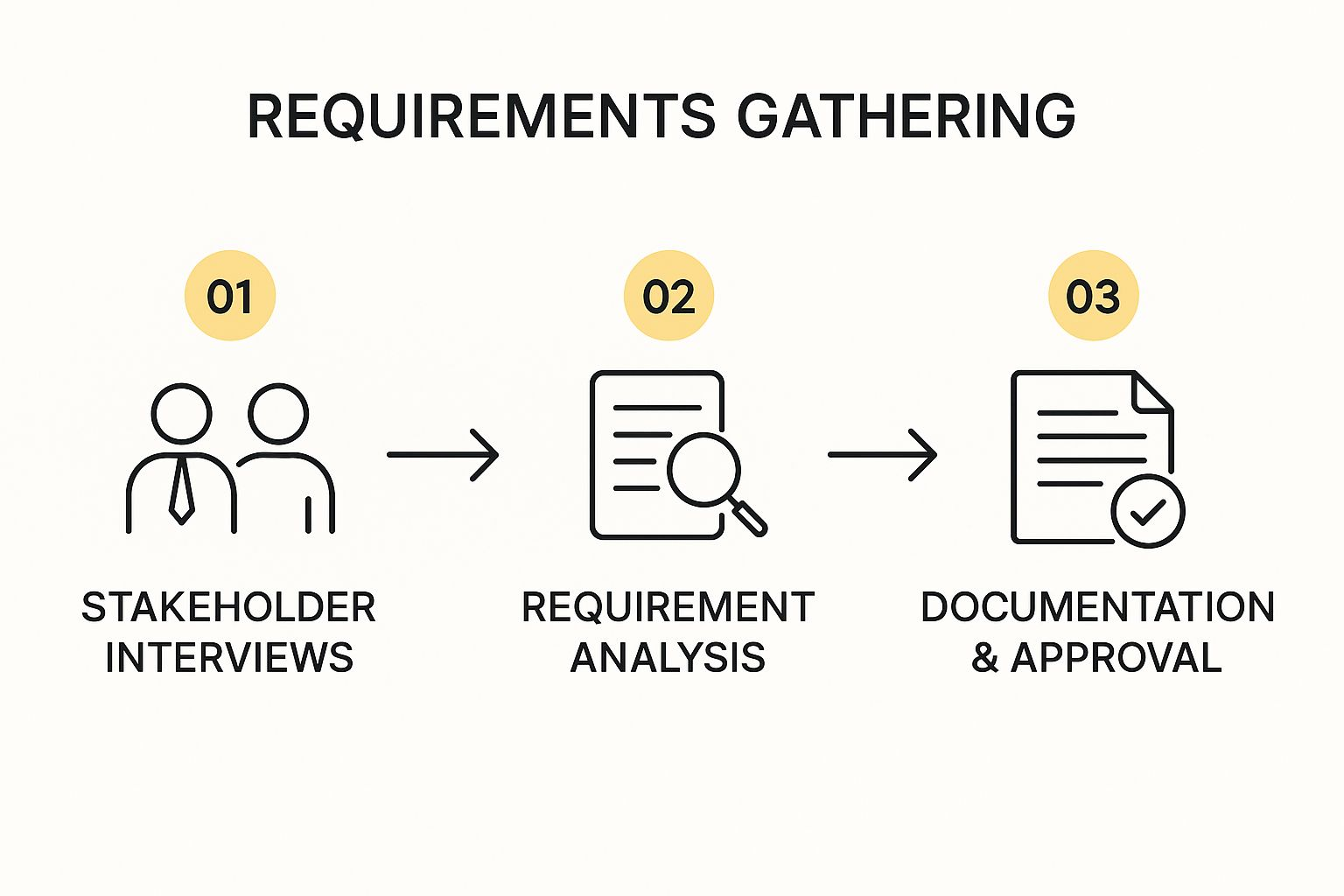When your business runs on a unique set of processes, off-the-shelf software often feels like forcing a square peg into a round hole. It almost works, but never quite right. This is exactly why so many businesses eventually turn to custom web application development—it’s about creating software designed from the ground up to solve your specific problems.
It’s the difference between buying a house someone else built and hiring an architect to design your dream home.
Why Build a Custom Web Application?
Choosing between ready-made software and a custom build can feel like a big decision. Here’s a good way to think about it: off-the-shelf software is like renting a fully furnished apartment. It's convenient, you can move in fast, and it gets the job done for now. But you can't knock down walls, add a new room, or change the plumbing when your needs change. You’re stuck with someone else’s blueprint.
Building a custom web application, on the other hand, is like designing and building your own house. Every single room, feature, and workflow is built around your life and your needs. You decide the layout, the materials, and how it can expand down the road. Sure, the upfront investment in time and money is higher, but you end up with an asset that perfectly fits your operations and grows right along with you.
To make this even clearer, let's break down the differences side-by-side.
Off-the-Shelf Software vs. Custom Web Application
| Feature | Off-the-Shelf Software | Custom Web Application |
|---|---|---|
| Functionality | Generic features for a broad audience. You get what you get. | Built specifically for your unique processes and workflows. |
| Scalability | Limited. You're dependent on the vendor's roadmap and pricing tiers. | Highly scalable. It can grow and adapt as your business evolves. |
| Integration | May have standard integrations, but custom connections are often difficult. | Can be designed to integrate seamlessly with your existing tools. |
| Control & Ownership | You license the software; you don't own it. You're subject to vendor changes. | You own the intellectual property. Complete control over features and data. |
| Initial Cost | Lower upfront cost (usually a subscription fee). | Higher initial investment for development. |
| Long-Term ROI | Can have hidden costs, recurring fees, and costs from inefficiency. | Higher long-term return through improved efficiency and scalability. |
| Competitive Edge | None. Your competitors are likely using the same tool. | A significant competitive advantage tailored to your business model. |
While pre-built software seems like the easy route, it often creates more friction in the long run. A custom solution is built to remove that friction entirely.
Solving Unique Business Challenges
The main reason people go custom is to solve problems that generic software just can't touch. A standard CRM might be fine for a typical sales team, but what if your company has a complicated, multi-stage client onboarding process with specific compliance checks? A pre-built tool will probably force you into awkward workarounds, which means wasted time and a higher chance of errors.
A custom web app is designed to embrace that complexity, not fight it. It automates your exact workflow, connects perfectly with the other tools you already use, and gives your team and customers a user experience that makes sense for them. This approach turns a clunky, manual process into something that’s smooth, efficient, and far less prone to mistakes.
A Strategic Investment in Growth
It’s a mistake to look at custom development as just another expense. It’s a strategic investment in your company’s ability to scale and compete. Because you own the application, you can modify and expand it whenever your business grows, you add new services, or the market changes. You’re not locked into a software vendor’s feature roadmap or their ever-increasing prices.
A custom application gives you complete control over your digital tools, allowing your business to pivot and innovate without being held back by software limitations. This autonomy is a powerful competitive advantage in a fast-moving market.
This isn’t just a niche idea anymore; it’s a major industry trend. The global custom software development market, valued at USD 43.16 billion in 2024, is expected to skyrocket to USD 146.18 billion by 2030. That kind of growth shows a massive shift as more businesses realize how powerful bespoke technology truly is.
When you align your technology directly with your business goals, you end up with a more efficient, agile, and resilient organization. To see how this works in the real world, explore our web development services and see how a solution built just for you can drive your success.
The Custom Web App Development Lifecycle
Building a custom web app is a lot like building a custom home. You wouldn't just show up with a pile of lumber and start nailing boards together. You need a plan, a blueprint, and a clear sequence of steps to make sure the final product is exactly what you envisioned. Each phase sets the stage for the next, turning an idea into a real, working asset for your business.
This structured process isn't about red tape; it's about making sure every decision has a purpose and that the app you get is the app you actually need.
Let's walk through the key phases of bringing a custom web app to life.
Phase 1: Discovery and Strategy
This is, without a doubt, the most important phase. It's where we nail down the "why" behind your project. A great app isn't just a collection of cool features—it solves a real, painful business problem. Think of this as the foundation work; if you get it wrong, the whole structure is unstable.
We dig deep during this phase:
- Defining Business Goals: What, exactly, will this app accomplish? We need specific, measurable outcomes. Think things like increasing sales by 20%, cutting down customer support tickets by 30%, or automating a manual process that eats up 40 hours a week.
- Identifying Key Performance Indicators (KPIs): How will we know if we succeeded? This could be user engagement, conversion rates, or how long it takes someone to complete a task. Setting clear KPIs from the start avoids any guesswork later on.
- User and Market Research: Who is going to use this thing? What are their biggest frustrations? What are your competitors doing well—and where are they falling short? This research ensures we build something people actually want to use, not just something we think they want.
This all comes together in a detailed project scope and a requirements document. This document becomes our North Star for the entire project.
The process for gathering these requirements is pretty straightforward.

This simple flow—from interviews to formal approval—makes sure everyone is on the same page before a single pixel is designed or a line of code is written.
Phase 2: UI and UX Design
With a solid strategy in hand, we can now focus on what the app will look and feel like. This is where we figure out the difference between an app that's a joy to use and one that makes you want to throw your laptop out the window.
There are two sides to this coin: UI (User Interface) is the visual part—the colors, fonts, and buttons. UX (User Experience) is the overall feeling a user gets. Is it intuitive? Confusing? Delightful?
The process usually starts with wireframes, which are like basic architectural sketches of each screen. From there, we create high-fidelity mockups and interactive prototypes. This lets you click through a simulated version of the app and give feedback before development starts, which saves a massive amount of time and money on changes down the road.
Phase 3: Architecture and Development
Here’s where the digital construction really begins. This work happens in two streams that run at the same time but are completely dependent on each other.
- Backend Development: This is all the stuff you don't see—the foundation, the plumbing, the electrical wiring of the app. It’s the server, the database, and the core logic that powers everything. It handles security, processes data, and makes sure the whole thing is fast and can handle growth.
- Frontend Development: This is the part you do see. It’s the interior design, the paint on the walls, and the light fixtures. Developers take the approved UI/UX designs and turn them into a living, breathing, interactive interface that people can click, tap, and swipe.
A well-architected backend is the key to a fast, secure, and scalable app. A well-built frontend is what makes good on the promises of the design phase.
Phase 4: Quality Assurance and Testing
Let’s be honest: no app is perfect on the first try. That’s what the Quality Assurance (QA) phase is for. It’s a methodical hunt for bugs, glitches, and anything that makes the app frustrating to use. A dedicated QA team puts the application through its paces on different browsers, devices, and operating systems.
A project that skimps on testing is a project destined for failure. Launching a buggy application can do irreparable damage to your brand reputation and user trust.
Testing isn't just one step; it’s a whole cycle that includes:
- Functionality Testing to make sure every button and feature works like it's supposed to.
- Usability Testing to see if real people find the app intuitive and easy to navigate.
- Performance Testing to check its speed and how it holds up under heavy traffic.
- Security Testing to find and patch any potential weak spots.
Phase 5: Deployment and Maintenance
After the app passes QA with flying colors, it’s time to go live. The deployment phase is all about moving the application from a private development environment to a live server where your users can finally get their hands on it.
But the work isn't over. A web app isn't a "set it and forget it" kind of thing. Ongoing maintenance is what keeps it running smoothly for the long haul. This final, continuous phase involves monitoring performance, squashing any new bugs that pop up, applying security patches, and making sure the app stays compatible with new browsers and operating systems.
Consistent maintenance is what keeps your custom web application secure, fast, and reliable for the people who depend on it.
Choosing the Right Technology Stack

Picking the right technology stack for your custom web app is a lot like choosing an engine for a vehicle. You wouldn't put the same engine in a high-performance race car that you'd put in a heavy-duty truck built for hauling massive loads. It’s not about which engine is "best" overall, but which one is perfect for the job at hand.
In the same way, your app's technology stack—the combination of programming languages, frameworks, and tools—isn't a one-size-fits-all decision. It's a strategic choice that will directly influence your app's performance, how easily it can grow, and what it will cost to maintain down the road. The whole point is to land on a set of tools that perfectly aligns with your business goals.
Understanding the Core Components
A tech stack has several layers, but for a business leader, it’s most helpful to think about the three main parts that work together to bring your application to life.
-
The Frontend (The Showroom): This is everything your users see and interact with—the user interface (UI), the buttons, the forms, and the entire visual experience. Just like a car's dashboard and interior, it has to be intuitive and well-designed. Common tools here include frameworks like React, Vue.js, and Angular, which help developers build those slick, responsive interfaces efficiently.
-
The Backend (The Engine Room): This is all the server-side logic humming away behind the scenes. It handles things like user authentication, data processing, and the core business rules that make your app actually work. Technologies like Node.js, Python (with Django), and PHP (with Laravel) are the powerful engines driving all that functionality.
-
The Database (The Fuel Tank & Cargo Hold): This is where all your application's data lives. Whether it's user profiles, product catalogs, or transaction records, the database keeps that information organized, secure, and ready to be retrieved. Popular choices include PostgreSQL for highly structured data and MongoDB for more flexible, document-style data.
Choosing a technology stack is less about chasing the trendiest new tool and more about making a sound strategic decision. The right stack should empower your development team to build effectively while ensuring the final product is scalable, secure, and ready to handle whatever your business throws at it in the future.
How Project Goals Guide Technology Choices
There is no single "best" tech stack. The right choice is always dictated by your specific project requirements and what you want to achieve long-term. An experienced development partner will walk you through these decisions, focusing on what really matters.
For instance, if your main goal is speed to market for a Minimum Viable Product (MVP), a framework like Ruby on Rails or Laravel might be the best bet. They come packed with pre-built components that can seriously accelerate the initial build.
On the other hand, if high performance and scalability are non-negotiable for an app expecting heavy traffic, like an e-commerce platform, a combination like React for the frontend and Node.js for the backend is a popular and powerful choice. That setup is well-known for its ability to handle tons of concurrent connections without breaking a sweat.
The industry is constantly evolving, too. In 2023, the global custom software development market hit an impressive US $35.42 billion, with much of that growth driven by modern tech. For example, artificial intelligence (AI) is now being integrated to create hyper-personalized user experiences, while low-code platforms are speeding up development cycles. You can dig deeper into the trends shaping the industry and see how technology is driving market growth on WeblineIndia.
Ultimately, any conversation about the tech stack is really a conversation about your business strategy. When you understand these core components and what influences the decision, you can have a much more productive dialogue with your development team. That collaborative approach ensures the technological foundation of your app is built not just for today, but for the future growth of your business.
Budgeting for Your Custom Web Application
Figuring out the budget for a custom web application can feel a bit like trying to hit a moving target. Unlike off-the-shelf software that comes with a neat price tag, the cost of custom development is shaped entirely by your business needs and your specific vision.
Think of it like commissioning a custom piece of furniture. A simple, functional bookshelf will have a much different price than an ornate, hand-carved cabinet with specialized compartments and intricate details. The investment for your app works the same way—it all comes down to the blueprint you and your development partner create together.
Key Factors That Influence Your Budget
A few core variables have a direct impact on the final cost of your web app. Getting a handle on these is the first step toward creating a realistic financial plan and dodging unexpected expenses later on.
- Project Complexity and Scope: A simple internal tool with a few data entry forms is worlds apart from a customer-facing portal that has to juggle thousands of users at once and handle complex business logic. The more features, user roles, and detailed workflows you need, the more development hours it will take.
- UI/UX Design Detail: A basic, template-based design is less expensive than a fully custom, branded user interface with unique animations and a highly tailored user experience. A high-fidelity design process involves more research, prototyping, and refinement, which adds to the budget but almost always leads to better user adoption and satisfaction.
- Third-Party API Integrations: Does your app need to talk to other software, like a CRM, a payment gateway, or a marketing automation platform? Each integration requires dedicated development effort to make sure data flows smoothly and securely between systems.
- Development Partner Choice: Who you hire to build the app has a big effect on the cost. An in-house team means dealing with salaries and benefits. Freelancers offer flexibility but might need more of your time to manage. A dedicated agency brings a full team of experts but usually represents a higher upfront investment.
Understanding Realistic Cost Ranges
Pinning down an exact number is impossible without a detailed project scope, but we can definitely look at some general estimates based on how complex an application is.
The table below breaks down what you might expect to invest based on the project's size and features. It gives a ballpark idea of the cost and timeline for different tiers of web applications, from a basic starting point to a more complex, enterprise-level solution.
Estimated Cost Breakdown by Application Complexity
| Application Tier | Estimated Cost Range | Typical Features | Estimated Timeline |
|---|---|---|---|
| MVP (Minimum Viable Product) | $15,000 - $30,000 | Core functionality, single user role, basic UI, minimal integrations. | 2-3 months |
| Standard Business App | $30,000 - $75,000 | Multiple user roles, custom UI/UX, key third-party integrations (e.g., payments), admin dashboard. | 3-6 months |
| Large-Scale Application | $75,000 - $150,000+ | Advanced features, high scalability, complex integrations, custom reporting, enhanced security. | 6-12+ months |
| Enterprise Solution | $150,000 - $500,000+ | Enterprise-grade security & compliance, multi-system integration, advanced analytics, full automation. | 12+ months |
Keep in mind these are just estimates. For example, a robust e-commerce site requires careful planning around product catalogs, secure checkouts, and order management systems. These features naturally push it into a higher complexity level than a simple content website. If you're curious about what goes into building a successful online store, you can learn more about our custom ecommerce web development services.
The crucial thing to remember is that you're not just buying software; you're investing in a business asset that’s built to grow with you. The real goal is to create a solution that generates value far beyond its initial cost.
Don't Forget the Hidden Costs
It's easy to focus on the initial build and forget about what comes after. To make sure your financial plan is solid, you have to account for the ongoing costs of keeping your application running smoothly.
These often include:
- Hosting: The servers where your application lives have a monthly or annual fee.
- Maintenance and Support: A retainer for ongoing bug fixes, security patches, and performance monitoring is absolutely essential.
- Future Feature Development: Your business will evolve, and your app will need to evolve with it. Setting aside a budget for future updates is what keeps your investment relevant and valuable for years to come.
Essential Practices for Project Success

Let's be real: a great idea and a talented dev team are just the entry fee. They don't automatically get you a winning project. The road to a finished custom web app is full of potential traps, from mismatched expectations to budgets that get blown up by feature requests.
The projects that succeed versus the ones that stumble often come down to a few core practices that guide how everyone works together.
Think of yourself, the business owner, as the captain of a ship. The development team is your expert crew—they know how to work the sails and read the currents. You don't need to know every knot, but you must set the destination, communicate it clearly, and make the tough calls when a storm rolls in. These practices are the map and compass that keep the whole voyage on course.
Adopt an Agile Mindset
Old-school, rigid project plans look great on paper, but they tend to shatter the moment they meet the reality of development. A much better way to work is with an Agile methodology. This isn't about having no plan; it’s about having a plan that can actually bend without breaking.
Agile breaks down the massive job of building an app into small, bite-sized cycles called "sprints." At the end of each sprint, the team delivers a working, testable piece of the application. This approach has some serious perks:
- Adaptability: It lets you make smart adjustments based on early feedback. This ensures the final product is something people actually want to use.
- Early Wins: You see real, tangible progress on a regular basis, which keeps everyone motivated and confident.
- Risk Reduction: Problems get spotted and squashed early on, before they can grow into project-killing monsters down the line.
Foster Clear and Consistent Communication
Communication is the absolute lifeblood of a custom software project. If there’s one thing that kills progress, it's ambiguity. You have to establish clear, consistent ways of talking with your development partner. It's simply non-negotiable.
This means way more than just one big kickoff meeting. It's about regular check-ins, honest progress reports, and creating an environment where asking questions is encouraged. A true partnership is built on open dialogue, where developers feel safe raising technical flags and you feel empowered to give candid feedback.
A project’s success is directly proportional to the quality of its communication. When stakeholders and developers are working in separate bubbles, you often end up with a product that technically works but completely misses the point of the business problem.
Define Concrete Milestones and Manage Scope
One of the biggest threats to your timeline and budget is scope creep. It's that slow, quiet, and uncontrolled trickle of "can we just add..." feature requests. The best defense is to define clear, concrete milestones right from the very beginning.
Think of these milestones as checkpoints. They are tangible goals tied to specific pieces of work, letting everyone see how progress stacks up against the original plan.
When a great new idea for a feature pops up—and it will—it doesn’t just get tossed onto the pile. Instead, it gets weighed against the project's core goals. Is this absolutely essential for launch, or is it a "Phase 2" kind of thing? This disciplined approach is what keeps a project focused and on the rails.
In the end, successful projects are built on a foundation of trust, clear communication, and solid collaboration. The best way to get a feel for a development partner's process is to look at the work they've already done. You can explore our portfolio of successful custom applications to see how putting these principles into practice leads to powerful, effective business tools.
Your Pre-Launch Checklist for Success

Starting a custom web application development project is a big commitment. We've covered a lot of ground, and this final checklist pulls it all together into something you can actually use. Think of it as your final pre-flight check before you give the green light.
A little planning goes a long way in turning a complicated process into a series of manageable steps. If you take the time to answer these questions honestly, you'll gain a ton of clarity, build confidence, and make sure your project starts on solid ground. This isn't just busywork—it's how you build a powerful business asset that actually delivers.
Strategic Foundations
Before you even think about talking to developers, you need to have your core strategy locked down. If your goals are fuzzy, you’ll end up with an unfocused project and a lot of wasted time and money. Use these questions to get your vision crystal clear:
- Problem Definition: Have I nailed down the specific business problem my app will solve? Could I explain it to someone in a single, clear sentence?
- User Understanding: Do I really know my target users? What are their biggest headaches, what do they need, and what do they expect from a tool like this?
- Success Metrics: What does a "win" actually look like? Have I defined concrete, measurable goals (like reducing manual data entry by 50% or improving customer retention by 15%)?
A custom app's value isn't measured by how many features it has. It's measured by its ability to solve a specific, well-defined problem. Keeping this front and center prevents scope creep and ensures the whole project is tied to real business results.
Partner and Process Readiness
Once you've got your strategy sorted, the next step is to make sure you're ready to work effectively with a development partner. It's a two-way street.
- Team Alignment: Is everyone on my team on the same page about the project's goals and what's most important?
- Budget Clarity: Is our budget realistic for what we want to build? Have we accounted for ongoing costs like hosting, maintenance, and future updates?
- Partner Vetting: What are the most important questions I need to ask potential development partners about their process, how they communicate, and their experience with projects like mine?
Frequently Asked Questions
Thinking about building a custom web application for the first time usually brings up a lot of questions. You know you need something more powerful than a standard website, but the path from idea to reality can feel a little hazy. We get it.
Let's clear up some of the most common things business owners and project managers ask before they even get started.
What’s the Difference Between a Website and a Web App?
This is probably the most common question we hear, and the answer really boils down to one simple word: interaction.
A classic website is mostly for showing information. Think of it like a digital brochure—its main job is to present content for people to look at or read. The user is a passive visitor, just taking in what's there.
A web application, on the other hand, is built for users to do something. It's a full-on program that runs right in your browser. People don't just consume information; they actively create, change, and work with data.
- Website Example: A local brewery’s site that lists their beers, taproom hours, and address.
- Web App Example: Google Docs, where you’re actively writing, formatting, and saving documents.
At its core, a custom web app is designed to help your users (or your team) accomplish a specific task, turning your digital presence from a simple sign into a powerful business machine.
How Do I Protect My Intellectual Property?
Your idea is the most valuable part of your business, so protecting it is absolutely non-negotiable. When you partner with a professional development agency, this isn't an afterthought—it's a fundamental part of the process.
The most straightforward way to protect your IP is with a solid contract. This legal document should spell out, in no uncertain terms, that you (the client) retain 100% ownership of all source code, designs, and anything else created for the project once the final payment is made.
Before a single line of code is written, you should also have the agency sign a Non-Disclosure Agreement (NDA). This legally binds them to keep your concept and business details completely confidential. A trustworthy agency won't just agree to this; they'll expect it and often insist on it to build a foundation of trust.
Do I Need a Technical Co-Founder to Build a Web App?
This is a huge fear for so many non-technical founders, but the answer is a firm no. You absolutely do not need to be a coding whiz or give away a chunk of your company to a technical co-founder to bring a brilliant idea to life. Your expertise is in your industry and your vision—that's what really drives a project forward.
Instead of hunting for a co-founder, you can hire a dedicated development agency. This approach actually gives you a few major advantages:
- You get an entire team of specialists—project managers, UI/UX designers, backend developers, and quality assurance testers—not just one person.
- You keep full ownership and control over your project and your business.
- The agency is accountable for delivering a high-quality product on a schedule and budget you both agree on.
Partnering with a skilled agency lets you fill the technical gap without sacrificing equity or control. Your job is to be the expert on the business problem you're solving; their job is to handle the technical execution.
Ready to turn your vision into a powerful, secure, and fully-owned web application? Up North Media specializes in creating custom solutions that drive growth and efficiency. Start your journey with a free consultation today.
